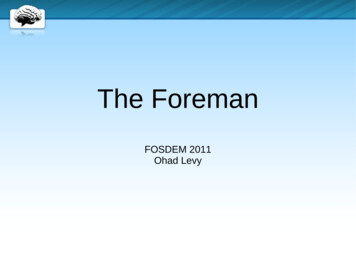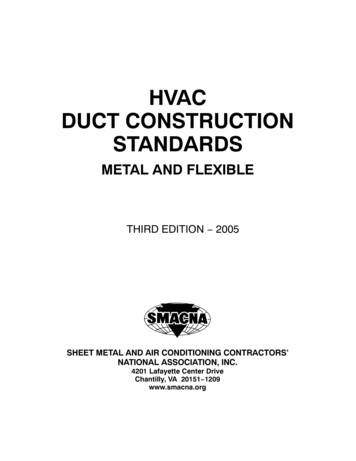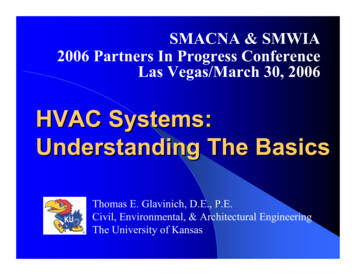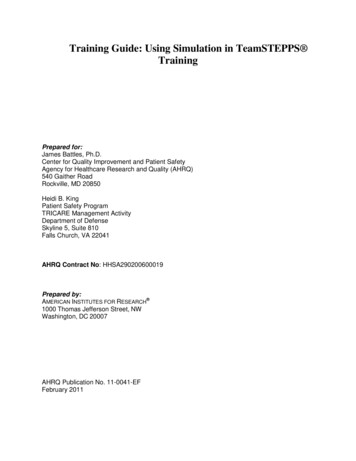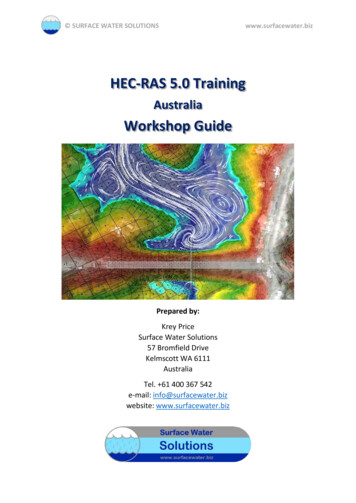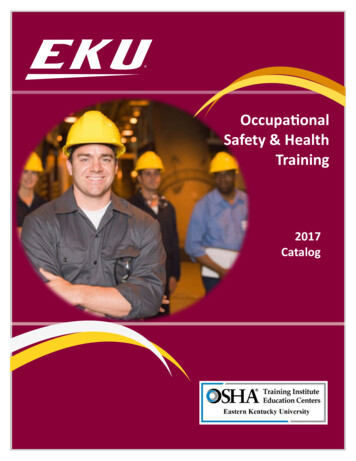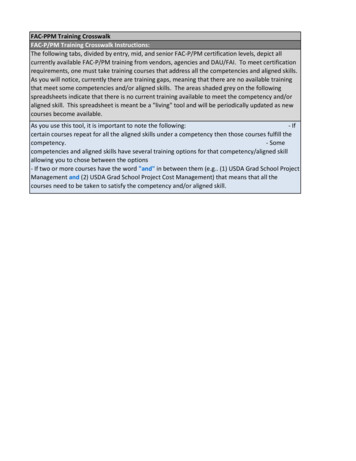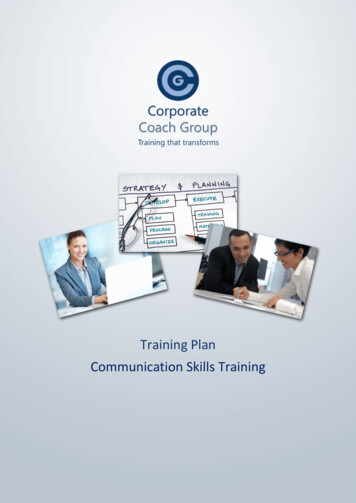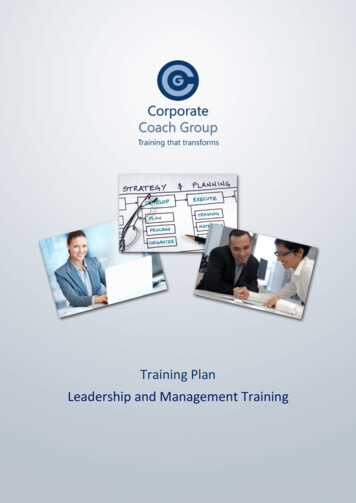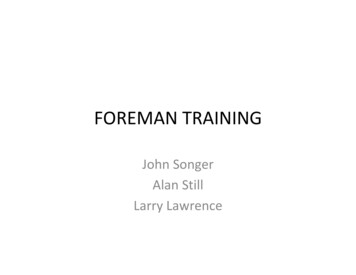
Transcription
FOREMAN TRAININGJohn SongerAlan StillLarry Lawrence
WANTED: FOREMANLooking for highly motivated, well trained,responsible leaders who can look after a job as goodor better than I will. Who treats the jobsite as if itwere his own company, where every dollar andevery minute is spent wisely. This is going to be thetoughest job in my organization. You must be willingto do whatever it takes to make your job successful.
WANTED: FOREMANYou will be expected to be efficient in: Time Management Blue Print Reading Problem Solving Specifications People Skills Building Codes Organization OSHA Regulations Cost Awareness Estimating Employment Laws Training Paperwork and Filing Communication Layout Union Rules Measuring Job Coordination Equipment Operation
WARNING!If something goes wrong it is your fault! We lowered our number to get the jobYou be about 2 weeks behind when youstartThe drawings are wrong and notapprovedYou’ll be undermannedWe don’t have enough toolsThe safety man is a jerkThe engineer graduated from UNLVIf you need hardware steal it from theother tradesThe Project Manager is an ex‐IronworkerThe block foreman can only read a rulein 8” increments The shop is buriedThe inspector is going to look forproblems to put on his reportThe drywall company is paying its guyspieceworkIf you need to move material borrow alullWe cant afford to rent a scissor lift sosteal oneThe GC is looking to screw you inanyway possibleOne of your guys is addicted to drugsThe owners son is on the jobYour wife hates you!
BENEFITS It pays 2.15 more You’ll be the last one laid off UNLESS WE FIRE YOU!
THE MOST IMPORTANT GUY IN YOURORGANIZATION?
Company ManagementOwnerEstimatorProject ManagerShopFieldShop ForemanDrafting DepartmentField SuperintendentOutside EntitiesJobsiteGeneral ContractorMechanical ContractorSafety GuySubcontractorOther TradesFOREMANWorkforceLead eerInspectorSuppliersUnionFire Marshall
FOREMAN TRAINING How did we do it in the past?– School of hard knocks What is it’s importance?– Owner– Union– Apprentices
The Need Training Training Training
Why ForemanTraining?A survey was conducted of areacontractors to assess the need forForeman Training
1. Do you have enough foremen to perform thework you currently have efficiently?
2. Are your foreman adequately trained to runany job you get?
2. Challenges When Bidding Work
Do you feel the Union has an adequate supply ofqualified foreman?
Have the foreman you currently employ beenthrough a formal foreman training program?
Do you have a formal in house foreman trainingprogram?
Does your JATC have a Foreman Trainingprogram?
Would your company benefit from a formaltraining program for foreman?
Would you be willing to offer incentives to youremployees if they would take a foreman trainingcourse?
The Creation of A Foreman!!!!!!!!! Training available Methods of teaching Who should teach it
ITI Foreman Training1. Introduction: Roles of Foreman, What isLeadership, Responsibilities of Foreman2. Self Evaluation :Basic Qualifications, AmI Foreman Material, How Motivated areyou to Lead3. Successful Foreman Attributes:Integrity, Communication Skills,Leadership, Self Motivation, DecisionMaking Skills, Positive Thinking, ProperAttitude, Appropriate Appearance4. Managing and Leading Others:Motivation, Personnel Cost Awareness,Labor Assignments, Timekeeping, WorkerEvaluation, Mediation and ConflictResolution, Personnel Issues5. Project Management: Understanding aProject, Plans and Specifications, Projectcost Awareness, Planning, ToolsEquipment and Materials, Meetings,
ITI Foreman Training (Continued)5. ( Project Management Cont). Documentsand Documentation, LegalConsiderations, Job Closeout6. Safety Culture: Safety Enforcement,Safety Standards, Safety Documentation7. Human Relations: PersonnelManagement, Diplomacy8. Professional Development:Organization, Time Management,Continuing Education
ITI Project Management1. The Project Manager: Managing theProject, Manage People, EnsureSafety, Make a profit2. Construction Documents: TheContract, The Specifications, ThePlans, the Submittals, Shop Drawings,Coordination Drawings, As BuiltDrawings3. Controlling Costs: Job Costs andProfits, Direct Job Costs, Indirect JobCosts , Profit, Controlling Costs, LaborCost, Material Costs, Status Reports,Purchasing, Billing4. Preparing the Project: Review theDocuments, Job Site Inspection, Meetwith the Project Team, Meet with theGC, Set Up a File System
ITI Project Management( Continued)5. Schedules and Meetings: Scheduling, BidSchedule,Master Schedule, Sub Contractor Schedule, Labor andJob Supervision Schedule, Fabrication Schedule,Purchasing and Delivery Schedule, Billing Schedule,Revising Schedules, Meetings, Pre ConstructionConference, Coordination Meetings, In HouseProject Review6. Paperwork : Project Documentation, Site VisitReports, Daily Job Log , Status Report, RFI, ChangeOrders, Estimating Costs to Change Work, TrackingCosts, Equipment Documentation, Labor Reporting7. Quality Control and Productivity: Productivity,Managing Productivity, Pace of Work, Number ofWorkers, Support of Crews, More Efficient Work,Quality Control and Responsibilities
ITI Project Management( Continued)8. Tools, Equipment and Materials:Material Handling, Purchasing, Receivingand Storage, Tools, ConstructionEquipment, Scaffolding, Vehicles,Swapping and Trading9. Legal Considerations: Contracts, ProjectManagers Responsibilities, Claims,Avoiding Claims, Documentation, AlternateDispute Resolutions, When to File a Claim,Procedures, Labor Relations, EEO andAffirmative Action10. Completing the Project: PreliminaryPunch List, Preliminary Inspection, StartUp of Installed Equipment, Preparation forStart Up, Operating Instructions andWarranties, Other Services, Close Out,Final Punch List and Inspection,Demobilization, Project Review( Customerand In House)
ITI Supervisory Training Program1. Leadership and Motivation : Roles of aForeman, Responsibilities of Superintendant,The Skills a Sheet Metal Supervisor Needs,What a Supervisor Needs to Know, WhatContractors Look for in a Supervisor.2. Communication Skills : A Working Definitionof Communication, Communication is Affectedby (Location, Personalities, Body Language),The Lost Art of Listening, How to VerifyCommunication Accuracy, Cross CulturalCommunication3. Contract Administration: Expectations of theParties to a Contract, Types of Contracts(Express, Implied, Negotiated), ApparentAuthority, Content of Construction ContractDocuments, Purpose and Use of Specifications,How contracts are Changed (Altered)
ITI Supervisory Training Program(Continued)4. Project Organization: The Importance ofPeople and staffing the Project, Thesupervisor’s Role in Bringing the ProjectTeam Together, The Significance of the KickOff Meeting, The Establishment of Job siteProcesses, and Procedures, The Importanceof Material Handling and EquipmentAvailability.5. Project Administration and Supervision:Administrative Systems, Pre ConstructionPlanning, Basics of Scheduling, Short IntervalPlanning, Importance of Labor Reporting, SubContract Management, Managing EquipmentCosts, Managing Quality Control, ChangeOrder Costs and Management, Importance ofAS-Built Drawings, Final Ten Percent andProject Close Out.
ITI Supervisory Training Program(Continued)6. Managing Productivity and Profits: TheRelation Ship Between Productivity and Profit,Factors that affect Productivity, Elements ofProductivity Management, IdentifyingProductivity Opportunities, MeasuringProductivity and Un- Productivity, Dealingwith Resistance to Change, Steps forProductivity Improvement.
Other Curriculums Available to Assistin the Creation of a Foreman (ITI andOther Sources)
Delivery Methods for Curriculum Start teaching Curriculum to apprentices as early astheir Second yr in the Program. Offer to both apprentices and Journeypersons as acontinuing education course. (Allows bothJourneypersons and apprentices to be workingtowards same goal) Give Real world scenarios at your facility. (Mock BidProjects, Duct Take Off exercises, Cost AwarenessExercises, Competitive Bid Projects between classes)
Delivery Methods for Curriculum(Continued) Utilize Specialized Curriculum Areas toPerform entire project scenarios (TABB,Industrial, Architectural, Service, Residential,Detailing) Assign Class Foreman to perform tasks at yourTraining Facility and give performance reviewsfrom peer as well as instructors so that yourstudents may better ascertain there strongand weak points.
Delivery Methods for Curriculum(Continued) Contractually (CBA) allow apprentices in the lastsemester of their fourth yr of apprenticeship to runwork to receive practical application of skills learnedat training facility. Allow Coordinators, Instructors to attend CompanyForeman’s Meetings to better ascertain the needs ofthe contractors so that curriculum can be geared tothe needs of the industry.
Who Should Teach this Curriculum? Instructors that are on Staff that have been or are CurrentlyForeman and that also have good instructional skills. Superintendants as guest speakers that also have goodinstructional skills. Project Managers of both large and small Contractors thathave good instructional skills Contractors of both Large and Small Companies so that thestudents can realize the different needs of each. SMACNA Representatives as Guest speakers
All of us Q&A
ITI Supervisory Training Program 1. Leadership and Motivation: Roles of a Foreman, Responsibilities of Superintendant, The Skills a Sheet Metal Supervisor Needs, What a Supervisor Needs to Know, What Contractors Look for in a Supervisor. 2. Communication Skills: A Worki
